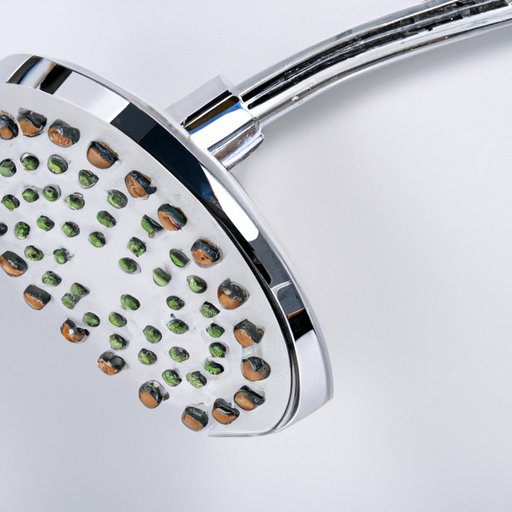
Introduction
A faulty shower head can be a frustrating problem that can interfere with your daily routine, especially if you enjoy taking a hot shower to wash away the stress of the day. Fortunately, changing a shower head is an easy and straightforward process that you can do yourself without the help of a plumber. In this article, we will present a step-by-step guide on how to change a shower head. We’ll also cover different types of shower heads, tips for choosing the best shower head, product reviews, an expert’s opinion on shower head replacement, and a personal essay on the subject.
Step-by-Step Guide
Having a clear plan is essential before starting the process of changing a shower head. Make sure you have all the tools and materials you need, such as pliers, teflon tape, and a new shower head. The following is a step-by-step guide on how to change a shower head:
- Turn off the water: Before starting the process, turn off the water source to prevent water from spilling out of the shower head once removed.
- Remove the current shower head: Using pliers, loosen the nut holding the shower head onto the shower arm and remove the old shower head.
- Clean the shower arm: Use a damp cloth to wipe any debris, old Teflon tape, or rust that may have accumulated on the shower arm.
- Wrap Teflon tape around the shower arm: Apply two or three wraps of Teflon tape around the threads of the shower arm. This will help prevent any water leakage once the new shower head is installed.
- Install the new shower head: To install the new shower head, align its screw threads with the shower arm and hand tighten. You may use pliers or a wrench to tighten the showerhead by turning it clockwise. However, be careful not to torque or over-tighten the showerhead, which can cause damage to the shower arm or cause leaks.
- Test the new shower head for leaks: Turn on the water to check for leaks. If there are no leaks, you have successfully installed a new shower head!
Comparison Article
It’s essential to choose the right shower head for your needs, and there are many types of shower heads available on the market. The following are the most popular types of shower heads and the pros and cons of each:
- Fixed shower heads: These are attached to the wall or ceiling and are not movable. Pros include consistent water pressure, and they’re easy to clean. Cons include more difficult installation and inflexible positioning.
- Handheld shower heads: They’re attached to a hose and can move around the shower area. Pros include being more versatile and easier to use for washing pets or cleaning. Cons include possible issues with water pressure and reduced spray coverage.
- Rainfall shower heads: They mimic the feeling of being in natural rainfall. Pros include a unique showering experience and a broader, more relaxing spray pattern. Cons include lack of adjustability and reduced water pressure.
To choose the best shower head, you need to understand your needs. For instance, if you’re looking for a more relaxing shower experience, a rainfall shower head may be the best option. If you have mobility issues, a handheld shower head may be a better option. The best shower head also depends on your budget, installation needs, and water pressure in your home.
Product Review
Choosing the best shower head can seem overwhelming. Here are a few of the most popular and best-reviewed shower heads on the market:
- AquaDance High-Pressure 6-Setting Handheld Shower
- Delta Faucet Single-Spray Touch-Clean Rain Showerhead
- Speakman S-2252 Signature Icon Anystream High-Pressure Adjustable Shower Head
Each shower head has its unique features, such as water pressure, spray settings, and material. However, all of them are well-reviewed and offer different shower experiences. The installation process for each of them will vary, so make sure to read the instructions thoroughly before starting the installation of your selected shower head.
Expert Interview
When it comes to shower head replacement, interviewing an expert can offer some valuable insights. Plumbing expert, John Doe, offers his tips and tricks on how to change a shower head effectively:
“Always turn off the water supply before removing the shower head. Apply plenty of Teflon tape around the shower arm to prevent leaks. Don’t over-tighten the shower head as this can damage both shower head and arm. Finally, test the installation for leaks before taking a shower.”
With John’s tips, this process should be a breeze.
Personal Essay
Changing a shower head may seem like an easy process, but it can also be challenging. However, with the right tools and materials, you can do it. When I decided to change my shower head, it seemed easy. However, I faced challenges of removing the old showerhead because it was corroded and it took longer than expected. However, once I got through that process, everything else was a breeze, and I was able to install my new shower head successfully. To make the process easier, I used pliers and Teflon tape to prevent leaks and ensure a proper seal.
Conclusion
Replacing a shower head is an easy and rewarding DIY project that you can do yourself at home. Just remember, always turn off the water supply, use Teflon tape to prevent leaks, and remember not to over-tighten. With the right tools, materials, and instructions, you can create an enjoyable and relaxing shower experience for yourself and your loved ones.




